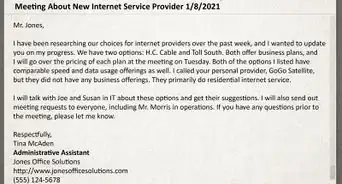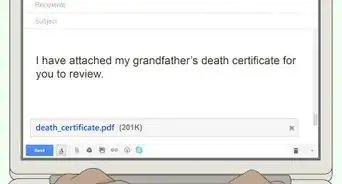This article was co-authored by Amber Rosenberg, PCC and by wikiHow staff writer, Christopher M. Osborne, PhD. Amber Rosenberg is a Professional Life Coach, Career Coach, and Executive Coach based in the San Francisco Bay Area. As the owner of Pacific Life Coach, she has 20+ years of coaching experience and a background in corporations, tech companies, and nonprofits. Amber trained with the Coaches Training Institute and is a member of the International Coaching Federation (ICF).
This article has been viewed 55,449 times.
If you’ve gotten a performance improvement plan (PIP) from your boss at work, you may view it as simply a list of reasons why you’re soon going to be fired. Some bosses do use PIPs in this way, so start looking for a new job if they show no interest in actually helping you improve based on the PIP. However, PIPs often can be used as blueprints for starting fresh and making a new and better impression in your current role. To make the most of your PIP, respond to it calmly and rationally, study it carefully, get clarifications as needed, and make the necessary changes to meet the goals it sets out for you.
Steps
Managing Your Initial Reaction
-
1Delay your response until you’re calm, composed, and focused. Resist the urge to respond to the PIP right away. You’ll be upset, afraid, and possibly angry, and your reaction will likely only make matters worse. Wait until the next day, or even after the weekend, before offering your full response to the PIP with your boss.[1]
- When you get the PIP, stick to a simple response like this: “Thank you for explaining your reasoning for this PIP. I’m going to take a good look over this tonight. Can we schedule a meeting tomorrow to discuss it in more detail?”
- If you've already made an immediate response that's negative or hostile, apologize as soon as possible: "I'm so sorry that my disappointment got the best of me, Alex. May I take some time to look this over so we can have a more fruitful discussion about it tomorrow?"
-
2Take time to read over the PIP carefully. Along with taking the time to cool down, make sure you pore over the PIP very closely. A well-made PIP should be full of specific details and actionable goals. Instead of skimming it over, take notes on it so you can discuss it in detail with your boss.[2]
- Work to keep your emotions in check as you read the PIP. Stop and take a few deep breaths as needed. No one likes to read negative feedback, but it’s important to keep a rational perspective.
Advertisement -
3Keep your ego in check as you absorb the PIP’s contents. If necessary, repeat the classic line from The Godfather to yourself: “It’s not personal, it’s strictly business.” A PIP is a standard business tool for assessing job performance, not an attack on your character. Don’t resent it, don’t ignore it, and don’t get overwhelmed by it. Instead, deal with it.[3]
- If it helps you, imagine that you’re reading someone else’s PIP. Disconnect it from you and read it for its specific content.
-
4Don’t waste time trying to rebut the PIP or pass blame to others. No matter how hard you try to keep calm and rational, you’re going to want to refute parts of the PIP. However, saying things like “That’s not my fault” or “That’s not accurate” won’t help your situation. Accept that this is how your boss perceives your performance, whether you feel it’s fair or not.[4]
- If you simply cannot accept the PIPs findings, it’s probably best to just start developing your exit strategy.
-
5State your acceptance of the PIP’s findings and ask for any clarifications. When you’re ready to meet with your boss to talk about the PIP, don’t be confrontational or apologetic. Be calm, serious, direct, and businesslike. Let them know clearly that you accept the PIP and want to move forward from that point.[5]
- No matter how direct and clear your PIP is, you’ll likely want some things to be clarified. Make this request in the same professional manner: “Mr. Stevens, I’ve read the PIP carefully and I accept its findings. There are a few areas where I’d appreciate a little further clarification, however. Can we talk about those?”
Focusing on Improvement
-
1Get more feedback, if needed, so your PIP has concrete steps and goals. Boiled down to its essence, your PIP should read like this: “You’ve fallen short in areas A, B, and C, and you need to do D, E, and F in order to keep your job.” If these elements aren’t crystal clear and actionable as written in the PIP, seek feedback from your boss until they are.[6]
- For example, a PIP shouldn’t say you need to get “better,” “faster,” etc. Instead, it should say that you need to “improve your sales figures by 30%,” or “increase your productivity by 4 units per week.” Make sure you get these specifics so you know exactly what you need to do.
-
2Conduct an honest self-evaluation of your ability to meet these goals. Once the specifics have been clearly defined, ask yourself the following: “Am I willing and able to do what the PIP requires?” If the PIP’s goals are not possible, or simply not worth your while, then it’s time to start looking for a new job.[7]
- Sometimes a PIP is simply the confirmation you need that a job isn’t the right fit for you. In this case, treat it as an opportunity to find something better.
- If you answer a clear “yes” to the question of your willingness and ability to meet the PIP's goals, get to work doing so!
-
3Treat the PIP as a fresh start if you’re determined to succeed in this job. You can use the PIP as motivation to find a new job, or as motivation to hit the “reset button” on your current job. In the latter case, use the PIP as your gameplan for starting fresh with a new focus and new goals.[8]
- Basically, envision your first day post-PIP as your first day on the job—minus getting to know everyone’s name! Instead of holding on to old habits, take a new approach to your job based on the benchmarks in your PIP.
- If you embrace this fresh start and run with it, your boss may forget their former concerns and see only the “new you” on the job.
-
4Focus on doing exactly what the PIP lays out for you. This goes hand-in-hand with forgetting your old ways and starting the job fresh. Your PIP should tell you exactly what’s expected of you and how to achieve it. Therefore, your best chance to impress your boss and save your job is to follow it to the letter.[9]
- If, for example, “improve customer satisfaction ratings by 25%” is part of your PIP, refocus your time and energy as needed to make this happen. If your PIP offers specific advice on how to do this, use it!
-
5Check in with your boss regularly during your PIP period. If your PIP period lasts for 1 month, for example, see if you can schedule a weekly meeting with your boss. During these meetings, discuss your efforts to make changes based on the PIP and continue to ask for feedback and clarifications. Show your boss that you’re determined to succeed.[10]
- Even if this effort isn’t enough to save your job at the end of the PIP period, you’ll make a positive impression on your boss. This will come in handy if, for instance, you need a reference for a new job.
Planning Your Exit Strategy
-
1Look for clues that your PIP is just a prelude to being fired. For some bosses and some companies, PIPs really are nothing more than documented justifications for letting people go. If PIPs have inevitably led to firings in your workplace before, it’s safe to assume that the same will happen in your case.[11]
- Also consider how your boss treats the PIP. If they show little interest in helping you improve, they’ve likely decided to let you go after the PIP period. For instance, if you ask for help in "improving cold-call sales by 30%" as stated in the PIP, and they respond with something like, "Ah, you'll figure it out," don't expect to be around much longer.
-
2Begin a discreet job search even if you hope to keep your current job. As the old saying goes, “Hope for the best, plan for the worst.” Start updating your résumé, searching for new jobs, and networking in your field, all without being obvious about it at your current job.[12]
- If you’re sure you can’t save your current job and it’s hampering your search for a new job, go ahead and talk to your boss about resigning.
-
3Negotiate a graceful exit with your boss if the writing is on the wall. Once you’re sure you’re going to be fired, you might as well exit on your own terms. There’s a good chance your boss will be happy to avoid having to explicitly fire you anyway, so talk to them about resigning discreetly.[13]
- Be polite and respectful, but direct: “Ms. Lowe, I appreciate the effort you put into crafting the PIP, but I feel it’s best if I seek a new opportunity elsewhere. Please take this as my 2 weeks’ notice.”
-
4Look for a mentoring boss rather than one who relies on PIPs. While PIPs are still widely used, more and more people in the business world see them as relics of the past. Instead of instilling fear through the threat of PIPs, opponents say, bosses should focus on engaging, encouraging, rewarding, and (most of all) leading their employees.[14]
- When you’re interviewing for a new job, evaluate your potential bosses. Do they strike you as mentors and leaders? Do you feel like they’d be dedicated to your success?
References
- ↑ https://www.payscale.com/career-news/2018/04/5-things-youre-put-performance-improvement-plan
- ↑ https://www.payscale.com/career-news/2018/04/5-things-youre-put-performance-improvement-plan
- ↑ https://www.fastcompany.com/90317142/how-to-respond-to-a-performance-improvement-plan
- ↑ https://www.payscale.com/career-news/2018/04/5-things-youre-put-performance-improvement-plan
- ↑ https://www.fastcompany.com/90317142/how-to-respond-to-a-performance-improvement-plan
- ↑ https://money.usnews.com/money/blogs/outside-voices-careers/articles/2016-08-04/what-to-do-if-youre-put-on-a-performance-improvement-plan
- ↑ https://www.fastcompany.com/90317142/how-to-respond-to-a-performance-improvement-plan
- ↑ https://www.fastcompany.com/90317142/how-to-respond-to-a-performance-improvement-plan
- ↑ https://www.inc.com/alison-green/what-to-do-when-youre-put-on-a-performance-improvement-plan.html
- ↑ https://money.usnews.com/money/blogs/outside-voices-careers/articles/2016-08-04/what-to-do-if-youre-put-on-a-performance-improvement-plan
- ↑ https://www.forbes.com/sites/lizryan/2016/04/08/the-truth-about-performance-improvement-plans/#42b743ee3b36
- ↑ https://www.inc.com/alison-green/what-to-do-when-youre-put-on-a-performance-improvement-plan.html
- ↑ https://money.usnews.com/money/blogs/outside-voices-careers/articles/2016-08-04/what-to-do-if-youre-put-on-a-performance-improvement-plan
- ↑ https://www.payscale.com/career-news/2018/04/5-things-youre-put-performance-improvement-plan









































































